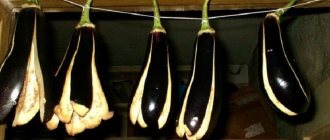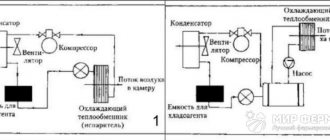Features of eggplant storage
The pulp of these vegetables contains a lot of active water , so they are not stored fresh for long.
Reference. Active (unbound) water accelerates biochemical processes in food products and promotes the spread of molds and other microorganisms. To prevent food spoilage, storage methods are used that inhibit internal chemical reactions: drying, freezing, canning.
The success of preserving fresh vegetables at home depends on three parameters :
- air humidity;
- temperature;
- illumination
Optimal temperature conditions for eggplants are +2…+6°C.
Suitable air humidity is 75–85%. Higher rates increase the risk of rot, and with low humidity the fruits lose their juiciness and wrinkle.
Lack of light is a prerequisite for storing this member of the nightshade family. When exposed to light, berries produce solanine, which is hazardous to health.
How long do fresh eggplants last?
Processed and canned vegetables last the longest. Average shelf life of fresh eggplants depending on storage location:
- cellar (basement) - 3-4 months;
- balcony (cold storage room) - 1 month;
- refrigerator - up to 2 weeks;
- at room temperature - about a week.
Fresh storage methods
Unlucky housewives, not knowing how to organize the proper storage of fresh eggplants at home, throw away vegetables purchased at a good price at the market or grown in the country. When there is no time for preparations, you can extend the shelf life of fresh fruits by placing them:
- on the bottom shelf of the refrigerator;
- to the basement, cellar;
- to the loggia (balcony).
On a note! Fresh eggplants quickly deteriorate in taste when stored in a warm room: the skin becomes lighter and signs of rot appear.
The vegetable compartment in the refrigerator is more suitable for storage. To keep the fruits longer, they should be wrapped tightly in cling film. But even in this case, you need to use the eggplants for their intended purpose within 2 weeks: prepare salads, stews, can, dry, freeze.
Basement or cellar
In a cellar or basement equipped with a ventilation system, blueberries do not spoil longer if optimal storage conditions are created:
- the temperature is maintained in the range of 3-5°C;
- humidity – at the level of 75-85%.
When lowering them into the cellar, they do not wash the fruits - dirt and moisture from the skin are removed with a dry rag. Fresh eggplants are stored in the cellar in several ways:
- The straw is laid along the wall, one layer of fruit is stuck in with the stalks down, the second layer with the stalks up, and sacks are thrown on top. Every 10 days an inspection is carried out to extend the shelf life; each eggplant is wrapped in paper.
- The fruits, wrapped in newspapers, are placed in plastic containers for vegetables, the boxes are placed on top of each other, and covered with burlap.
- Place in a cardboard box, the layers are sprinkled with dry sawdust mixed with wood ash.
- Suspended in a vegetable net.
Which eggplants are suitable for long-term storage?
In fresh form, late-ripening and mid-ripening varieties have the longest shelf life (for example, Torpeda, Romantika, Universal 6, Almaz).
To increase the period, the harvest is harvested in a timely manner (not earlier and not later) and the fruits are discarded according to shape and quality.
Fruit selection
High-quality eggplants are elastic with a dense, glossy skin , without deformation, mechanical damage and signs of rot and insect damage. The color and shape of the collected vegetables must correspond to the varietal characteristics.
Important! Both unripe and overripe eggplants are not suitable for long-term fresh storage. Consider the timing of technical ripeness of plants: for mid- and late-ripening varieties it is 120–130 days from the date of sowing.
The maturity of eggplants is also determined by their appearance . Overripe fruits, as a rule, have a matte skin, are lighter (as if faded), and have a soft structure. Unripe ones do not differ in color and size from ripe ones, but are noticeably lighter in weight.
How to properly freeze fresh eggplants
You can prepare fresh vegetables by simply not frying them in a pan. To do this, you need to wash the eggplants, sprinkle with salt and leave for half an hour. Next, you need to boil the vegetables in boiling water. This process will take five minutes. Now place on plates in one layer to cool. And put it in the refrigerator. After the eggplants are frozen, you need to put them in bags and put them in the freezer.
Before freezing vegetables, you need to look at their color. If after you cut it and it quickly turns brown, then there is no need to freeze such a vegetable. It will become bitter and not tasty.
These eggplants can be stored in the freezer for more than five months.
Harvesting from your own garden bed is the best method for preparing vegetables for long-term storage. To properly harvest, follow these tips:
The nuances of storing eggplants:
- storing eggplants in direct sunlight or in a very bright place is prohibited (vegetables will not only begin to deteriorate quickly, but also, due to their composition and chemical processes, can be harmful to health after consumption);
- late-ripening varieties of eggplant are more adapted to long-term storage than other varieties;
- For long-term storage, eggplants with the most elastic, smooth and undamaged skins and green stalks are selected (soft eggplants or vegetables affected by diseases cannot be stored);
- You can store eggplants in an open plastic bag in a dark and cool place or in the refrigerator;
- instead of a plastic bag, you can use newspaper or any paper (this method is used not only when storing in the refrigerator, but also if there are a lot of vegetables and they have to be placed in boxes);
- if eggplants are stored in boxes, it is recommended to sprinkle them with river sand (sand will retard the evaporation of moisture, so the vegetables will remain juicy and fresh for a long time);
- It is not recommended to wash eggplants before any storage method (you can wipe the surface of the vegetables with a napkin if there is significant dirt on the skin);
- before freezing, eggplants must be blanched for several minutes in boiling water (this nuance will help preserve the structure of the vegetables after further defrosting);
- when freezing, it is recommended to place eggplants in plastic bags or cling film, having previously excluded even the slightest accumulation of air (it is not recommended to freeze eggplants in containers);
- with insufficient air humidity, eggplants lose their juiciness, and their surface becomes wrinkled (the optimal humidity for this type of vegetable is 85-90%);
- In the refrigerator, eggplants should be stored separately, avoiding their contact with other vegetables or fruits (the rotting process may be accelerated due to such contact).
Preparing eggplants for storage
Vegetables are harvested in dry weather, but not in the very heat . Cut specimens suitable for ripeness, leaving stalks 3–5 cm long.
Before storing, cut eggplants are ventilated for a day in the fresh air , protected from direct sunlight (covered with burlap, put in the shade). A dark room with good ventilation is suitable for drying vegetables. If ventilation is not possible, wipe the fruits with a dry cloth.
Important! Eggplants intended for fresh storage should never be washed. Water removes the protective coating from the skin and reduces the natural biological immunity of vegetables.
Storing Fried Eggplants
To begin with, washed and chopped vegetables are salted and kept in a container for up to several hours. Then the juice is drained, and the entire cutting is blotted with a paper towel. Roasting occurs in the usual way.
After heat treatment, vegetable fat is removed from the vegetable slices as much as possible. This is where paper towels come in handy again.
Once the vegetables have cooled, place them on a flat surface, such as a tray or wooden board, and place them in the freezer. You should not place the finished sliced eggplant slices on top of each other, as it will be more difficult to defrost them and they will lose their appearance.
Don't forget that you can season fried eggplants with herbs and spices before freezing. It's even better to marinate them in herbs just before frying.
Advice! If storing on a tray takes up too much space, once the chopped vegetables are completely frozen (a day later), you can remove them and transfer them to smaller containers.
How to store eggplants at home
When keeping unprocessed eggplants, the main goal is to preserve their beneficial properties, freshness, juiciness and texture.
Cellar or basement
These places are most suitable for long-term storage of vegetables . Temperature, humidity, shading in the basement conditions are close to optimal. The main thing is that the indicators remain stable, without sudden changes.
The most popular storage methods in the cellar:
- laying in layers on the ground/floor/shelves (previously covered with straw);
- storage in boxes with holes;
- storage in hanging nets.
In the vegetable storehouse, air ventilation and insulation of fruits are provided . To do this, eggplants are wrapped in paper and laid in layers sprinkled with sawdust, ash or river sand.
Important! Do not forget to sort through vegetables from time to time, choosing spoiled ones, and monitor the microclimate in the room.
Balcony
On an insulated (glazed) balcony, fresh eggplants are kept in boxes . The bottom is covered with a thick bedding of straw, the vegetables laid in layers are covered with dry sand or ash. The boxes are covered with burlap on top to protect them from light and cold. When the air temperature drops below +2°C, vegetables are insulated by throwing on, for example, an old blanket or rug.
Fresh eggplants are stored on the balcony for about a month, depending on the weather.
Where and how to store the eggplant harvest
In order for eggplants to retain their presentation, freshness and maximum nutrients until spring, you can send them for storage either in the cellar or find the optimal place in the apartment. You should also know certain rules that will help protect the product from spoilage.
At home
The technology for preserving vegetables in an apartment is relevant for city dwellers who do not have a cellar. There are several ways to preserve the taste and natural freshness of vegetables at home.
In a refrigerator
The shelf life of eggplants in the refrigerator is 2 weeks. To do this you need:
- Dry the vegetables.
- Wrap each fruit in paper.
- Place the prepared vegetables into containers and close with a lid.
- Place in the compartment for vegetables and fruits.
- The paper should be replaced every 2-3 days.
Following simple rules will allow you to avoid wasting the product and get the maximum benefit.
On the balcony
When choosing a balcony for storage, it is important to take into account the main requirement: it must be insulated. Each fruit must be wrapped in cling film, carefully placed in a wooden box and covered with burlap so that light does not fall on the product.
Sunlight negatively affects eggplants because when exposed to sunlight, the vegetables produce solanine. This substance makes the fruit tasteless, bitter and harmful to health.
You should also monitor the temperature on the balcony. Do not keep the door open, otherwise the temperature in it will become equal to room temperature. Under such conditions, the fruits will quickly lose moisture, dry out and wither.
To increase shelf life, it is recommended to sprinkle the fruits in the box with river sand. It will delay the evaporation of moisture, as a result the product will retain its juiciness and freshness.
In the pantry
When choosing this storage method, you need to take into account that the pantry should be located away from heating radiators. The room temperature should not be higher than +7-8°C. To keep the product fresh as long as possible, each eggplant can be wrapped in paper and placed in a cardboard box.
In the freezer
Unlike other vegetables, it is not recommended to freeze fresh eggplants, since this reduces the taste characteristics and reduces the amount of minerals and vitamins in the fruit.
How to properly freeze eggplants:
- Rinse vegetables using running water. Cut off the ends and any damaged areas.
- Cut into cubes, slices, rings, depending on personal preference.
- Prepare a solution (dissolve 100 g of salt in 1 liter of water).
- Soak the fruits in the solution for 40-60 minutes (the larger the slices, the longer they will soak). This manipulation neutralizes the specific bitterness of eggplant.
- Perform heat treatment using any method.
- Place the product on a paper towel to dry when blanching or boil and drain fat when frying.
- Place the vegetables in one layer so that they do not come into contact with one another.
- Place in the freezer until frozen.
- Remove and place in vacuum-sealed plastic bags or plastic containers. It is better to package it in small portions, since it is not recommended to re-freeze the product.
The most common methods for processing eggplants include:
- blanching, in which chopped vegetables are placed in boiling water for a very short time (4-5 seconds);
- cooking, which involves immersing the product in salted boiling water for 5 minutes;
- baking fruits in an oven preheated to 200°C on a baking sheet greased with vegetable oil;
- frying vegetables on both sides in a heated frying pan, without bringing them to readiness.
Due to heat treatment, the result is semi-finished products from which you can make delicious stews, sautés, and all kinds of snacks.
How to freeze eggplants for the winter:
In the cellar
The best solution would be to send the eggplants to the cellar for storage. At the same time, air must constantly circulate in the storage, and the humidity level should not exceed the norm. There should be no temperature changes, as this significantly reduces the shelf life of eggplants.
Methods for storing eggplants in the cellar:
- In sand or ash . To do this, take wooden boxes. Place a 2 cm layer of sand or ash on the bottom, put the fruits and sprinkle the selected material on top again. You can make up to 3-5 layers.
- In sawdust . In the cellar, dig a hole in the ground to the height of one and a half eggplants. Cover with sawdust and insert fruits wrapped in paper so that the cuttings are located below. When installing the second row, the eggplant cuttings should be located at the top, and the fruits themselves should be between the vegetables of the first tier. Sprinkle sawdust on top. It is important to constantly inspect the vegetable product; if the paper is damp, it should be replaced with dry one.
- In paper bags . You can put 1-3 eggplants in each sealed package, release the air and secure with thread. Then put the bags in any drawer and leave them on the floor.
- In paper on straw . Each vegetable must be wrapped in paper. It is not recommended to use printed publications, since printing ink has a negative effect on the product and reduces its beneficial properties. The wrapped fruits must be laid out on shelves, previously covered with dry straw with a layer of up to 3 cm. Cover them with burlap on top.
Before storing eggplants in the cellar, you should prepare the room by cleaning it, disinfecting it, insulating it and protecting it from excessive dampness. Only then will it be able to fully perform the function of a home vegetable storage facility.
Other methods
Other storage methods involve heat treatment, which increases the shelf life of products . In such cases, early ripening varieties of eggplant are also used, and the requirements for the quality of the fruits themselves are reduced.
In the freezer
Freezing is an economical storage method , especially for city residents who do not have a cellar or basement.
Important! Properly frozen vegetables preserve their vitamin and taste properties and save time when using them for food.
How to prepare eggplants for freezing:
- Washing, peeling and slicing - the fruits are cut into cubes, rings, slices, large pieces, and left whole.
- Soaking in salt water removes bitterness. The duration of the procedure is 0.5–1 hour, depending on the size of the pieces.
- Preliminary heat treatment prevents the quality and taste of the pulp from deteriorating.
The simplest heat treatment includes:
- blanching - boiling for 5 minutes in salted water;
- light baking in the oven or frying in a pan.
After heat treatment, lay the eggplants on a paper napkin to drain excess oil and cool.
It is better to freeze in portions so that the pieces do not stick together. To do this, the processed slices are laid out on a tray (board, baking sheet) in one layer and sent to the freezer.
After the pieces have frozen to the required hardness, they are poured into bags or containers, and the next portion of eggplants is placed on the tray.
Semi-finished products prepared in this way are stored in airtight containers for quite a long time , up to a year. In winter, they are used to prepare vegetable stews, appetizers, side dishes and other dishes.
Dried
dried vegetables does not require the creation of special conditions . However, there is an opinion that dishes prepared from such eggplants do not taste good.
There are three ways to dry eggplants:
- in the oven;
- in an electric dryer;
- on open air.
In the first case, washed and chopped fruits are spread in a thin layer on a baking sheet (without oil) and placed in an oven preheated to +200°C. Drying is carried out at a temperature of +100°C for 5-6 hours with the door ajar.
It is convenient to dry vegetables in an electric dryer , where the appropriate mode and time are set (on average 7-8 hours).
The third method is the least reliable , since dry weather is required throughout the entire period for a high-quality result. Eggplants, cut into pieces 1.5–2 cm thick, are loosely strung on a thread or laid out in a thin layer on a flat surface. Dry them in a shaded, dry place with good ventilation for about 5–7 days.
The finished pieces are packaged in paper bags, fabric bags or other airtight containers and stored at room temperature. Such preparations are suitable for food for at least a year.
Reference. A type of dried vegetables is dried. To do this, the fruits are partially dehydrated, and the temperature and duration of drying are reduced. Such semi-finished products are stored in the refrigerator, in glass jars filled with vegetable oil.
Canned
The most common way to preserve crops is canning . Eggplants are salted, fermented, pickled, prepared in the form of salads or traditional eggplant caviar.
There are many recipes for cooking vegetables, especially in the national cuisines of southern countries. Below are some simple options.
Salted eggplants
Place chopped fruits in an enamel pan (or other container for pickling), add chopped dill and garlic to taste, sprinkle with salt (at the rate of 2-3% relative to the weight of vegetables), and mix.
The workpiece is aged under pressure for 2–4 days at room temperature until the brine becomes cloudy. Store the finished pickles in a cool place (for example, a refrigerator). After a week, the eggplants are ready to eat.
Pickled eggplants
Whole fruits are cut lengthwise to 2/3 of the thickness and boiled in plenty of salted water for 10 minutes. For the filling, grated carrots, chopped herbs, garlic, walnuts, etc. are used in various combinations. Minced meat is generously added to the inside of each eggplant (in the cut).
The fruits are wrapped with threads so that they do not fall apart. The stuffed vegetables are placed in an enamel pan and completely filled with brine (1.5 liters of water, 80–90 g of salt). The fermentation is infused under pressure for several days, then transferred to a cool place for storage.
Eggplant appetizer with vegetables
Vegetables are cut into slices, add salt and fry in a frying pan. Fried eggplants are placed in sterilized jars in layers, alternating them with fresh peppers, tomatoes, carrots, onions, celery, and parsley.
The layers are sprinkled with salt, pepper, and spices to taste. The mixture is poured with heated vegetable oil, the jars are sterilized in the usual way. The preparations are stored at room temperature.
Store eggplants in the refrigerator
Freezing
Never immediately freeze fresh eggplants for the winter - it will be impossible to eat them later.
First you need to wash them, remove the stalks, peel off the skin if it is rough, and cut it into circles, cubes, slices. The chopped fruits are placed in a container, poured with cold water so that it covers them completely, and salt is added (about 1 tablespoon per 1.5 liters).
After 25-30 minutes, the water is drained, the eggplants are washed and blanched in boiling water for 15-20 seconds. The cooled pieces are dried, laid out in one layer on a cloth or napkins. They also cover the top to prevent it from getting too windy.
After 2-3 hours, if possible, the eggplants are laid out on cutting boards, trays, baking sheets and placed in the freezer. They will freeze in 3-4 hours - now you can put them in special hermetically sealed bags and put them away in a permanent storage place. If you put them in bags at once, do not forget to shake them vigorously several times so that they do not freeze into one big lump.
You can also fry the eggplants before freezing them. They must first be washed, peeled if desired and cut into circles or slices. Then cover them with salt and leave for about an hour. Rinse again in cold water, fry in a hot frying pan in any vegetable oil until golden brown and place on napkins to drain. Then you can lay it out and put it in the freezer compartment of the refrigerator.
Bake
You can store baked eggplants in the refrigerator. The washed fruits are pricked with a fork in several places, large ones are cut in half. Then they are placed on a baking sheet, lightly greased with vegetable oil, and placed in the oven for 20-25 minutes at a temperature of 180ºC. The skins are peeled off the cooled fruits, placed in this form in bags, sealed plastic containers or ordinary jars and put away for storage.
Useful tips
For successful storage of fresh eggplants at home:
- vegetables are provided with suitable conditions: a cool, dark place with constant humidity of about 80%;
- use ventilated boxes with holes or baskets: vegetables deteriorate rapidly in closed, tight containers;
- isolate fresh fruits from each other and from the external environment (the best solution is bags made of thick paper: they are gas-permeable and provide the necessary darkening, protect vegetables from drying out and rotting);
- limit the contact of eggplants with other vegetables and fruits that produce ethylene during ripening (tomatoes, bananas, apricots, plums, pears).
How to store eggplants in the basement or cellar
Vegetables are perfectly stored in these places. But in this room the air must circulate, the percentage of humidity should not exceed the norm. The ideal option is constant parameters, without changes. Various jumps reduce the shelf life several times.
There are two methods that are suitable for storing vegetables in a basement or cellar after you have harvested:
- Cover the ground with straw and place the eggplants. In the first row you need to lay the cuttings down, and the second row uses a slightly unusual method: each eggplant needs to be stuck between two fruits in the first row. Now all this needs to be covered with a bag. After 10 days you will need to sort out the fruits. Everything that is damaged should be thrown out, and the rest should be wrapped in paper and laid out in the same way, swapping the bottom and top rows. If the temperature tends to zero, then cover the ground more densely with straw. Another option is bags and blankets.
- Wrap each eggplant in paper and place it in a box with special holes to allow air to circulate. Cover the top with sawdust, old newspapers or straw.
How and for how long to store tomatoes in the refrigerator?
Storing tomatoes in the refrigerator
- I would like to say right away that tomatoes do not tolerate low temperatures quite well, so they should be stored in the refrigerator only as a last resort. And they must be placed there fully ripe. If you put a completely green tomato in the refrigerator, then due to lack of heat it simply will not be able to ripen and in the end you will still have to throw it away.
- It is best to store tomatoes in a fresh zone, where the temperature is always approximately the same. You need to put them in a container for vegetables literally in two rows. If you plant a lot of them, it is likely that the lower fruits will become crushed and begin to rot while lying for a long time.
- And if you use an old model of refrigerator, then additionally put newspaper or a cotton towel in the drawer with the tomatoes. They will be able to absorb excess moisture, which in turn will prevent the proliferation of putrefactive microflora.
We invite you to familiarize yourself with Greenhouses: types of greenhouses and selection criteria
Adviсe
If you know the secrets and subtleties of storing, collecting and preparing eggplants and know how to apply them in practice, you can greatly simplify your life.
- If you want to preserve the integrity of eggplants in an apartment environment, you can use paper bags. Just put each one in a separate bag and put it in a cool place. Due to excellent breathability, the fruits will be stored for a long time.
- Nowadays there are various refrigerators. If you have the No frost function, then eggplants can be stored for up to 2 months.
- You should pay attention to the color of the eggplants; if, after cutting them, they immediately turn brown, then you should not freeze them, as they will be bitter later.
- You shouldn’t stop at just one option for storing blueberries; to know all the tastes and nuances, you should try making a little of each type.
- If you want the fruits to freeze in a short period of time, then you should cut them into small cubes and lay them out in one layer.
If all conditions are met, you can preserve all the beneficial elements that eggplant contains, as well as diversify your diet with nutritional qualities. With proper processing, you can enjoy the taste of your favorite vegetables until spring.
Dried vegetables
Many housewives also like to cook dried eggplants for the winter. For the recipe you will need:
- fresh eggplants;
- garlic;
- or ;
- spices to taste.
You can dry eggplants in the oven or electric dryer. The resulting product should have a hard crust, but be soft inside. Place the cooled preparations in sterile jars, add garlic and spices. Fill the contents with hot oil and close the lids. Once the jars have cooled, place them in the refrigerator.
How to freeze eggplants for the winter
Freezing vegetables is good for long-term storage. In this state they can remain for a long time, and their beneficial properties are not lost. What I like most is that the preparation procedure is simple.
Fresh
Fresh preparation is the simplest, because preliminary heat treatment is not carried out.
For preparation you will need:
- eggplants - 0.5 kg;
- salt - 2 tbsp. l. with a slide.
Step by step steps:
- Wash the vegetables in water, remove the stems. Cut into pieces of the size you need (circles, stripes, squares, etc.).
- Transfer to a deep container. Pour salt into it and pour boiling water. Place pressure on top and leave for 25 minutes. Thanks to this, all the bitterness will go away.
- Then rinse the pieces under running water several times to remove any remaining salt and drain in a colander.
- Place in a freezer container or bag. Place in the freezer. Remove and shake periodically so that the slices do not freeze into a single ice lump and separate from each other without problems.
Shelf life is one year or more.
Not enough citrus fruits in winter? Then you will need information on how to store oranges at home so that they last a long time.
Without soaking, the pieces will taste bitter after defrosting.
Fried
If you prepare fried eggplants, then after defrosting you don’t even have to cook them: you can serve them immediately. And there will definitely be no bitterness.
The procedure is like this:
- Cut the fruits into rings (1-1.5 cm thick).
- Heat vegetable oil in a frying pan. Place on medium heat.
- Fry on each side for a few minutes until golden brown.
- Then place the blue ones on a paper towel to remove excess fat. At the same time, the pieces will dry out.
- Place them on a baking sheet or board. Place in the freezer for 1-2 hours so that the vegetables are “set” by frost.
- Remove and place in bags or containers. Place in the freezer for permanent storage.
The shelf life in this condition is up to a year.
Author's note Natalya Papanova Blog author
After defrosting, you can prepare the same dishes from fried vegetables as from fresh ones.
Blanched
To prevent eggplants from becoming bitter after freezing, you can still blanch them
. I do it this way:
- I wash the fruits, cut off the tails and cut the pulp into the pieces I need.
- First, bring the water to a boil in a saucepan. I put it next to it. pan with cold water. To further lower the temperature, I throw in about 5-10 ice cubes.
- I pour pieces of blue ones into boiling water. I blanch briefly (2-3 minutes). Immediately after, I take it out with a slotted spoon and throw it into cold water.
- Next, I do the same as in the previous version: I froze it first and then put it in the freezer for storage.
Shelf life - up to a year.
If you want to prepare other crops, then read how to store rosemary.
Dried
Dried eggplants can be prepared in two ways: whole and in pieces.
Dry in pieces like this:
- Clean the fruits from dirt and dust, remove the tails and cut into pieces of the shape you need. The main thing is that they are not very thick, otherwise they will not dry out.
- Cover a baking sheet with parchment paper and grease with vegetable oil. Arrange the pieces in one layer.
- Place in the oven preheated to 180 degrees for 30 minutes.
- Remove, place the blue ones on a paper napkin and let cool completely.
- Pack into bags or containers and place in the freezer. Remove and shake periodically to prevent an ice lump from forming.
For the workpiece in its entirety, follow these steps:
- Make a couple of punctures in the washed vegetables with a toothpick or fork. Place on a baking sheet lined with parchment paper.
- Place in the oven preheated to 150 degrees for an hour.
- Then remove the eggplants, cut off their tails and make a longitudinal cut. Open the blue ones slightly.
- Place in a colander and press down with a weight. Leave in this state for 30-40 minutes.
- Then distribute into bags. I advise you to add vegetables one at a time so that it is easier to defrost later and they do not stick together.
Vegetables can remain in this state for 12 to 14 months.
If you follow all the procedures correctly, the vegetables will not taste bitter.
How to freeze blanched eggplants
Place the sliced eggplants in a colander and place in boiling salted water for 2-3 minutes. If the eggplants float, press them down with a spoon or slotted spoon.
Transfer eggplants to ice water and cool completely. Then drain in a colander to drain excess liquid. To speed up the process, you can weigh down the vegetables with a weight.
Place the cooled eggplants in containers or bags. There is no need to freeze them first.
Cool slightly and spread the eggplants in a single layer on a tray, flat dish or cutting board. Place in the freezer for an hour until the vegetables are slightly frozen.
Drying fruits
Long-term storage of eggplants is also possible if they are dried. This can be done in different ways.
Preliminary preparation of the product is limited to cleaning, washing, cutting and drying. You can even use overripe vegetables; whether to leave the peel or not is a matter of taste for each housewife.
At home, use an oven or electric dryer to prepare:
- In the oven. First hold the product at a temperature of 200 °C. Open the door often to stir and ventilate the workpieces. After an hour, reduce the temperature to 100 °C and leave for another 4-5 hours.
- In an electric dryer. Spread the vegetables in a thin layer. Maintain for 5-7 hours at a temperature of 50-60 °C, then let cool. Cooking times may vary slightly due to different cut shapes and dryer models.
Check readiness manually.
How to dry eggplants for the winter without using technology? Hang them on a thread or fishing line in a well-ventilated place. The pieces should not touch each other. In 2-3 weeks they will be ready.
Storing dried vegetables is very easy. Place them in bags or glass jars with lids and place them in a dry place. This could be a pantry, kitchen cabinet or table. The main thing is that light does not fall on the product and moisture does not penetrate inside the packaging.
Use dried eggplants to prepare the same dishes as raw ones. Just soak them in water first.
How long and at what temperature should eggplants be stored?
Air humidity when storing eggplants should be on average 80%. At different temperatures, the shelf life of vegetables can differ dramatically. You can store eggplants in a dark and cool place or in the refrigerator. Sometimes eggplants are frozen, but after defrosting, the structure of their pulp changes significantly, so they can only be used for preparing first or second courses, except for salads.
The relationship between temperature and shelf life of eggplants:
- When frozen, eggplants can be stored for several months;
- at a temperature of +2 degrees, eggplants are stored for an average of one month;
- at temperatures from +10 degrees and above, eggplants can remain fresh for several days (maximum 5-6 days);
- at temperatures up to +7 degrees, eggplants remain fresh and juicy for several weeks only when sprinkled with ash, sand or sawdust.
Eggplants can be stored for several months in sliced form. Cubes or rings of vegetables should be placed in a glass jar, sprinkling each layer with coarse salt. The preparation must be placed in the refrigerator, and the eggplants can be removed from the jar in parts. Before eating, vegetables should be soaked in water to remove salt.
- on the balcony;
- to the pantry;
- in a cellar or basement;
- in a refrigerator;
- in the freezer;
- in any dark place with the required temperature and humidity.
Is it possible and how can I store peeled potatoes in the refrigerator for the winter?
Storing potatoes in the refrigerator
- Peeled potatoes have one unpleasant feature: literally within an hour after you remove the peel from them, they will begin to oxidize and darken, and even cold air cannot stop this process. Therefore, if you want potatoes to retain their beneficial properties, then immediately after you peel them, immerse them in water.
- This is how you can store it in the refrigerator for 2 to 3 days. But the vegetable will remain normal during this time only if you change the water in the container in which it lies at least twice a day. If you do not do this, then the starch that is in the root vegetable will be released into the water and fermentation will begin in it. Literally a couple of hours after the start of this process, the potatoes will become covered with mucus and become inedible.
- When storing peeled potatoes, one more feature must also be taken into account. The longer it sits in water, the harder and more watery its structure becomes. Therefore, if you plan to make puree from it in the future, it will be better if it is in the water for no more than 12 hours. Unpeeled potatoes can be stored in the refrigerator for 2 to 5 months.
We invite you to familiarize yourself with the construction of turnkey fences
How and how long to store radishes in the refrigerator?
Storing radishes in the refrigerator
- There are several ways to store radishes in the refrigerator. If you need it to sit for no more than a week, then simply rinse it in clean water, let the excess liquid drain a little, and then put it in neat rows in a glass jar and cover everything with a plastic lid. Be sure to keep in mind that with this storage method, there should still be a little water in the jar.
- Therefore, if you put completely dry radishes into a container, be sure to pour a couple of tablespoons of clean liquid into it. If desired, the jar can be replaced with a plastic bag, but you will definitely need to make a couple of holes in it for ventilation. If you want to eat this healthy product all winter, then give it a place at the very bottom of the refrigerator.
- Place the radishes in a special box for vegetables and fruits and cover them with damp sand. It should be laid in rows, lightly compacting each layer. Only late varieties of radishes are suitable for this storage method.











